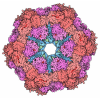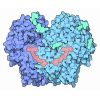Entry Database : PDB / ID : 3so6Title Crystal structure of the LDL receptor tail in complex with autosomal recessive hypercholesterolemia PTB domain LDL receptor adaptor protein Low-density lipoprotein receptor Keywords / / / / / / / / / Function / homology Function Domain/homology Component
/ / / / / / / / / / / / / / / / / / / / / / / / / / / / / / / / / / / / / / / / / / / / / / / / / / / / / / / / / / / / / / / / / / / / / / / / / / / / / / / / / / / / / / / / / / / / / / / / / / / / / / / / / / / / / / / / / / / / / / / / / / / / / / / / / / / / / / / / / / / / / / / / / / / / / / / / / Biological species Rattus norvegicus (Norway rat)Homo sapiens (human)Method / / / / Resolution : 1.37 Å Authors Dvir, H. / Zajonc, D.M. Journal : Proc.Natl.Acad.Sci.USA / Year : 2012Title : Atomic structure of the autosomal recessive hypercholesterolemia phosphotyrosine-binding domain in complex with the LDL-receptor tail.Authors : Dvir, H. / Shah, M. / Girardi, E. / Guo, L. / Farquhar, M.G. / Zajonc, D.M. History Deposition Jun 29, 2011 Deposition site / Processing site Revision 1.0 Apr 18, 2012 Provider / Type Revision 1.1 May 2, 2012 Group Revision 1.2 May 16, 2012 Group Revision 1.3 Nov 8, 2017 Group / Category / Item Revision 1.4 Feb 28, 2024 Group / Database referencesCategory chem_comp_atom / chem_comp_bond ... chem_comp_atom / chem_comp_bond / database_2 / struct_ref_seq_dif Item / _database_2.pdbx_database_accession / _struct_ref_seq_dif.details
Show all Show less
 Yorodumi
Yorodumi Open data
Open data Basic information
Basic information Components
Components Keywords
Keywords Function and homology information
Function and homology information
 Homo sapiens (human)
Homo sapiens (human) X-RAY DIFFRACTION /
X-RAY DIFFRACTION /  SYNCHROTRON /
SYNCHROTRON /  MOLECULAR REPLACEMENT /
MOLECULAR REPLACEMENT /  molecular replacement / Resolution: 1.37 Å
molecular replacement / Resolution: 1.37 Å  Authors
Authors Citation
Citation Journal: Proc.Natl.Acad.Sci.USA / Year: 2012
Journal: Proc.Natl.Acad.Sci.USA / Year: 2012 Structure visualization
Structure visualization Molmil
Molmil Jmol/JSmol
Jmol/JSmol Downloads & links
Downloads & links Download
Download 3so6.cif.gz
3so6.cif.gz PDBx/mmCIF format
PDBx/mmCIF format pdb3so6.ent.gz
pdb3so6.ent.gz PDB format
PDB format 3so6.json.gz
3so6.json.gz PDBx/mmJSON format
PDBx/mmJSON format Other downloads
Other downloads 3so6_validation.pdf.gz
3so6_validation.pdf.gz wwPDB validaton report
wwPDB validaton report 3so6_full_validation.pdf.gz
3so6_full_validation.pdf.gz 3so6_validation.xml.gz
3so6_validation.xml.gz 3so6_validation.cif.gz
3so6_validation.cif.gz https://data.pdbj.org/pub/pdb/validation_reports/so/3so6
https://data.pdbj.org/pub/pdb/validation_reports/so/3so6 ftp://data.pdbj.org/pub/pdb/validation_reports/so/3so6
ftp://data.pdbj.org/pub/pdb/validation_reports/so/3so6 Links
Links Assembly
Assembly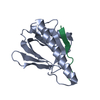
 Components
Components

 Homo sapiens (human) / References: UniProt: P01130
Homo sapiens (human) / References: UniProt: P01130 X-RAY DIFFRACTION / Number of used crystals: 1
X-RAY DIFFRACTION / Number of used crystals: 1  Sample preparation
Sample preparation SYNCHROTRON / Site:
SYNCHROTRON / Site:  SSRL
SSRL  / Beamline: BL11-1 / Wavelength: 0.97945 Å
/ Beamline: BL11-1 / Wavelength: 0.97945 Å molecular replacement
molecular replacement Processing
Processing MOLECULAR REPLACEMENT / Resolution: 1.37→23.56 Å / Cor.coef. Fo:Fc: 0.971 / Cor.coef. Fo:Fc free: 0.956 / WRfactor Rfree: 0.2093 / WRfactor Rwork: 0.1533 / Occupancy max: 1 / Occupancy min: 0.3 / FOM work R set: 0.8877 / SU B: 2.108 / SU ML: 0.039 / SU R Cruickshank DPI: 0.0691 / SU Rfree: 0.0675 / Cross valid method: THROUGHOUT / σ(F): 0 / ESU R: 0.069 / ESU R Free: 0.068 / Stereochemistry target values: MAXIMUM LIKELIHOOD
MOLECULAR REPLACEMENT / Resolution: 1.37→23.56 Å / Cor.coef. Fo:Fc: 0.971 / Cor.coef. Fo:Fc free: 0.956 / WRfactor Rfree: 0.2093 / WRfactor Rwork: 0.1533 / Occupancy max: 1 / Occupancy min: 0.3 / FOM work R set: 0.8877 / SU B: 2.108 / SU ML: 0.039 / SU R Cruickshank DPI: 0.0691 / SU Rfree: 0.0675 / Cross valid method: THROUGHOUT / σ(F): 0 / ESU R: 0.069 / ESU R Free: 0.068 / Stereochemistry target values: MAXIMUM LIKELIHOOD Movie
Movie Controller
Controller


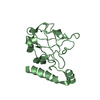

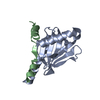
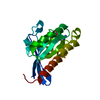

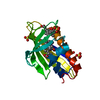
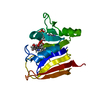
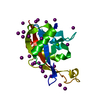
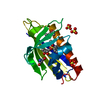
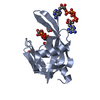
 PDBj
PDBj


